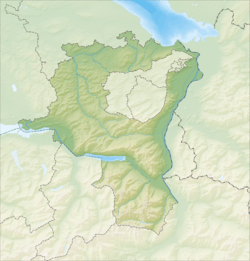Wittenbach facts for kids
Quick facts for kids
Wittenbach
|
||
|---|---|---|
 |
||
|
||
| Country | Switzerland | |
| Canton | St. Gallen | |
| District | St. Gallen | |
| Area | ||
| • Total | 12.2 km2 (4.7 sq mi) | |
| Elevation | 603 m (1,978 ft) | |
| Population
(Dec 2020 )
|
||
| • Total | 9,747 | |
| • Density | 799/km2 (2,069/sq mi) | |
| Postal code |
9300
|
|
| Surrounded by | Berg, Gaiserwald, Häggenschwil, Mörschwil, Roggwil (TG), St. Gallen, Waldkirch | |
| Twin towns | Wilburgstetten (Germany), Selma (Switzerland) | |
Wittenbach is a cool town, also known as a municipality, located in the Wahlkreis (which means constituency or voting district) of St. Gallen. It's part of the canton of St. Gallen in the beautiful country of Switzerland.
Contents
A Look Back: Wittenbach's History
Wittenbach has a long history! The first time anyone wrote about Wittenbach was way back in 1297. It was called Witebach then.
Exploring Wittenbach's Geography
Wittenbach covers an area of about 12.3 square kilometers (that's about 4.7 square miles). A big part of this land, about 58%, is used for farming. Forests cover about 20.9% of the area. The rest of the land, about 19.5%, has buildings or roads. A small part (1.5%) is made up of rivers or lakes.
The town is surrounded by two deep valleys called ravines. To the east, you'll find the Galgentobel ravine, formed by the Steinach creek. To the west, there's the Sitter river valley.
Wittenbach is made up of different parts. These include the main village of Wittenbach, plus smaller areas like Kronbühl and Bruggwaldpark. There are also some scattered homes and a special part called Hinterberg, which is an exclave (meaning it's a piece of land belonging to Wittenbach but not connected to the main part).
Wittenbach's Coat of Arms
Every town has a special symbol, and Wittenbach's is called a blazon or coat of arms. It shows three silver willow trees growing out of a wavy blue base on a red background. The wavy blue lines probably represent water, like a river or stream.
Who Lives in Wittenbach? Demographics
Wittenbach is home to many people! As of the latest count, its population is 9,747. In 2007, about 21.4% of the people living here were from other countries. Many different nationalities call Wittenbach home, including people from Germany, Italy, former Yugoslavia, Austria, and Turkey.
Most people in Wittenbach speak German, about 87.8% of the population. Other languages spoken include Serbo-Croatian and Albanian.
Age Groups in Wittenbach
Let's look at the different age groups in Wittenbach (based on data from 2000):
- About 11.2% of the population are children aged 0 to 9 years old.
- Around 13.6% are teenagers aged 10 to 19.
- Young adults (20-29 years old) make up about 12.3%.
- People aged 30-39 are about 15.5%.
- Those aged 40-49 are about 14.5%.
- People aged 50-59 are about 14.2%.
- Seniors (60-69 years old) make up about 9.8%.
- People aged 70-79 are about 5.8%.
- Those aged 80-89 are about 2.6%.
- A very small number, about 0.6%, are 90 years old or more.
How People Live: Households
In 2000, about 12.7% of people in Wittenbach lived alone. Many people, about 52%, lived in families with children. About 24.9% were couples without children. There were also single-parent homes and other types of living arrangements.
Voting and Politics
In the 2007 federal election, the most popular political party in Wittenbach was the SVP. They received 36.2% of the votes. Other popular parties included the CVP, the FDP, and the SP.
Education in Wittenbach
Education is important in Wittenbach! About 71.6% of adults (aged 25-64) have finished either upper secondary education (like high school) or even higher education, such as university. In 2000, about 39.9% of the population had finished their secondary education.
Wittenbach's Population Over Time
Here's how Wittenbach's population has changed over the years:
| year | population |
|---|---|
| 1831 | 1,322 |
| 1860 | 1,284 |
| 1900 | 1,849 |
| 1910 | 2,668 |
| 1950 | 2,393 |
| 1970 | 5,487 |
| 1990 | 7,910 |
Places to See: Sights in Wittenbach
Some areas in Wittenbach are very special and are protected as part of the Inventory of Swiss Heritage Sites. This means places like the hamlets of Dottenwil/Unterrüti and Unterlörenis are important historical or cultural sites.
Wittenbach's Economy: How People Work
In 2007, the unemployment rate in Wittenbach was about 3.01%, which means most people had jobs.
Wittenbach has different types of jobs:
- Primary Sector: This includes jobs like farming. In 2005, about 133 people worked in this area.
- Secondary Sector: This involves manufacturing and construction. About 964 people worked in these jobs.
- Tertiary Sector: This is the service industry, like shops, offices, and healthcare. About 1,758 people worked in this sector.
Many people who live in Wittenbach also work there. However, many residents (about 3,306) travel outside Wittenbach for their jobs. At the same time, about 1,347 people travel into Wittenbach to work.
Religion in Wittenbach
Based on the 2000 census, many people in Wittenbach are Christian. About 46.3% are Roman Catholic, and about 29.7% belong to the Swiss Reformed Church. There are also people who follow the Orthodox Church and other Christian faiths. About 5.88% of the population are Islamic. Some people belong to other religions, and about 7.59% do not belong to any church.
Getting Around: Transport in Wittenbach
Wittenbach is easy to reach by train! It's located on the Bodensee–Toggenburg line, which connects Romanshorn and St. Gallen. The town has its own train station, Wittenbach railway station, which is part of the St. Gallen S-Bahn (a local train system).
See also
 In Spanish: Wittenbach para niños
In Spanish: Wittenbach para niños




